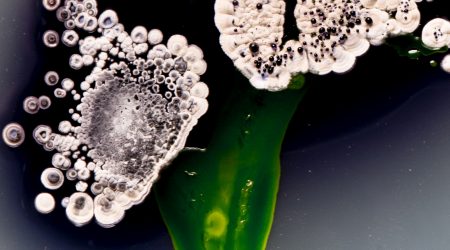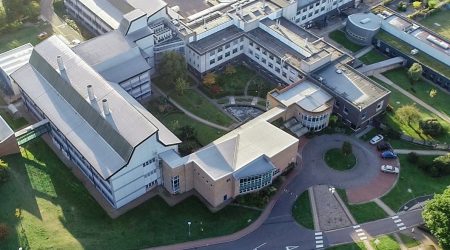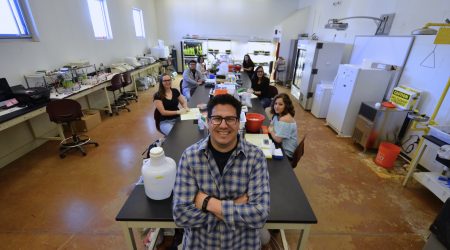A round-up of recent research from the John Innes Centre from winter 2020
Wrinkled ‘super pea’ could be added to foods to reduce diabetes risk
A type of wrinkled ‘super pea’ may help control blood sugar levels and could reduce the risk of developing type 2 diabetes.
Unlike regular (smooth) peas, wrinkled peas contain higher amounts of ‘resistant starch’, which take longer for the body to break down, preventing sugar spikes.
Over a series of experiments, the research team gave healthy volunteers meals containing wrinkled peas or pea flour and compared these to control experiments where volunteers were given smooth peas and their products.
Professor Claire Domoney’s group were part of the interdisciplinary research project collaborating with Imperial College London, Quadram Institute and University of Glasgow to use pea lines from the John Innes Centre’s Germplasm Resource Unit.
Research cracks RNA structural code to create opportunities for plant, animal and human health
Research from Dr Yiliang Ding’s group reveals how a newly discovered structural feature of RNA helps regulate gene activity with implications.
The team found it is the energetic accessibility – how easy it is to open the mRNA secondary structure – that determines whether an mRNA is cleaved by a miRNA.
They have also discovered a particular structure which they have named Target Adjacent Structure Motif (TAM), can promote miRNA cleavage.
As Dr Ding describes, “RNA is not a skinny molecule but has a toned structure – our fundamental discovery about the nature of this structure in living cells opens up exciting technological applications. Like the gene-editing tool CRISPR, it could be used to grow healthier and more sustainable crops. And though this work was carried out on plants, our findings may have important implications for improving RNA therapy in human health.”
Research gets to the heart of organ shape
Researchers have shed fresh light on the evolution and function of the shapes we see in nature – using as a model the heart shaped fruits of the Capsella genus.
This new study from the Østergaard group has revealed that modification of protein activity is critical for organ-shape formation.
Only via de-SUMOylation – a kind of molecular trimming activity – is a pathway activated which allows biosynthesis of the plant hormone auxin which in turn facilitates anisotropic cell expansion to form the heart-shaped Capsella fruit.
One of the next steps for the researchers is to translate this fundamental discovery from the research plant Capsella to the related commercial crop oilseed rape.
Made to ORDER: a web innovation for Brassica research worldwide
Researchers have launched a new web-based genomic tool for the global Brassica research community.
The ORDER (Oilseed Rape Developmental Expression Resource) browser uses transcriptome time series data and allows users to search for genes of interest and plot how these genes are expressed through a plant’s development.
This can reveal new relationships between genes and improve our understanding of regulatory networks, including those which impact on yield.
The team, spanning groups across the John Innes Centre, hope that this resource will become a go-to point for the community which will strengthen the John Innes Centre’s role as a hub for Brassica research and enable researchers from different fields to share similar time series data.
Read ‘Made to ORDER: a web innovation for Brassica research worldwide‘
Slow growth the key to long term cold sensing
Plants have to interpret temperature fluctuations over time periods – ranging from hours to months – to align their growth and development with the seasons.
Researchers in the groups of Professor Dame Caroline Dean and Professor Martin Howard have discovered that slow growth is used as a signal to sense long-term changes in temperature.
If the weather gets warmer, the plants grow more quickly and as cells multiply, the amount of a key protein, NTL8, becomes diluted. “This study shows the fantastic synergy when experimental approaches are combined with computational modelling.
We would never have figured out this mechanism by doing either separately,” says Professor Dean. The findings will be useful for understanding how plants, as well as other organisms, sense long-term fluctuating environmental signals.
Compounds show promise in search for tuberculosis antibiotics
Compounds tested for their potential as antibiotics have demonstrated promising activity against one of the deadliest infectious diseases – tuberculosis (TB).
Using X-ray crystallography, the team from Professor Tony Maxwell’s group elucidated the molecular details of the antibiotic candidate produced by the company Redx Pharma, against the target enzyme DNA gyrase.
Surprisingly, a very common mutation in DNA gyrase that causes bacteria to be resistant to a related group of antibiotics, the aminocoumarins, did not lead to resistance to the compounds under scrutiny here and opens the way for further synthesis and investigation of compounds that interact with the target.









